Documents: Go to download!
- Owner's manual - (English, Spanish)
- PARTS AND FEATURES
- INSTALLATION INSTRUCTIONS
- Refrigerator Use
- REFRIGERATOR FEATURES
- REFRIGERATOR CARE
- TROUBLESHOOTING GUIDE
Table of contents
User manual Refrigerator
PARTS AND FEATURES

*This instruction manual refers to several models. Features may vary according to model.
- Freezer door bin
- Dairy compartment for spreadable food items such as butter or margarine.
- Adjustable half width door bin
- Full width door bin
- Adjustable wire shelf
- Adjustable half width shelf
- Adjustable half width shelf with deli drawer
- Deli drawer
- Adjustable full width shelf
- Humidity controlled crisper drawer for storage of fruits and vegetables
- Ice tray (optional)
- Ice maker / Ice storage bin (optional)
INSTALLATION INSTRUCTIONS
Water Supply Requirements(optional)
This water line installation is not warranted by the refrigerator or icemaker manufacturer. Follow these instructions carefully to minimize the risk of expensive water damage.
Gather the required tools and parts before starting installation. Read and follow the instructions provided with any tools listed here.
Water Pressure
Important: A cold water supply with water pressure between 30 and 120 psi (207 and 827 kPa) is required to operate the icemaker.
NOTE: If the water pressure is less than what is required, ice cubes could be hollow or irregular shaped.
If you have questions about your water pressure, call a licensed, qualified plumber.
Reverse osmosis water Supply
If a reverse osmosis water filtration system is connected to your cold water supply, the water pressure to the reverse osmosis system needs to be a minimum of 40 to 60 psi (276 to 414 kPa). If the icemaker is still not operating properly:
- Check to see whether the sediment filter in the reverse osmosis system is blocked. Replace the filter if necessary.
- Allow the storage tank on the reverse osmosis system to refill after heavy usage.
Connect the Water Supply(optional)
Read all directions before you begin.
Important: If you turn the refrigerator on before the water line is connected, turn the icemaker OFF.
Connect to Water Line
1. Unplug refrigerator or disconnect power.
2. Turn OFF main water supply. Turn ON nearest faucet long enough to clear line of water.
3. Locate a Vi" to 1 Va" (1.25 cm to 3.18 cm) vertical cold water pipe near the refrigerator.
Important:
* Make sure it is a cold water pipe.
* Horizontal pipe will work, but drill on the top side of the pipe, not the bottom. This will help keep water away from the drill and normal sediment from collecting in the valve.
4. Determine the length of copper tubing you need. Measure from the connection on the lower left rear of refrigerator to the water pipe. Add 8 ft (2.4 m) to allow for cleaning. Use Va” (6.35 mm) O.D. (outside diameter) copper tubing. Be sure both ends of copper tubing are cut square.
5. Drill a Va" hole in the cold water pipe (even if using a self-piercing valve), using a sharp bit. Remove any burrs resulting from drilling the hole in the pipe. Take care not to allow water to drain into the drill. Failure to drill a Va" hole may result in reduced ice production or smaller cubes.
6. Fasten the shutoff valve to the cold water pipe with the pipe clamp. Be sure the outlet end is solidly in the Va" drilled hole in the water pipe and that the washer is under the pipe clamp. Tighten the packing nut. Tighten the pipe clamp screws slowly and evenly so washer makes a watertight seal. Do not overtighten or you may crush the copper tubing.

7. Place the compression nut and sleeve for copper tubing onto the end of the tubing and connect it to the shutoff valve. Make sure the tubing is fully inserted into the valve. Tighten the compression nut securely.
For plastic tubing, insert the molded end of the tubing into the shutoff valve and tighten compression nut until it is hand-tight; then tighten one additional turn with a wrench. Overtightening may cause leaks.
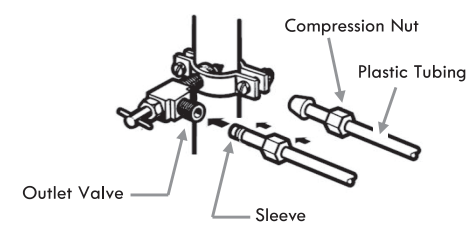
8. Place the free end of the tubing in a container or sink, and turn ON the main water supply. Flush the tubing until water is clear. Turn OFF the shutoff valve on the water pipe. Coil the copper tubing.
Connect to Refrigerator
1. Unplug refrigerator or disconnect power.
2. Remove the screws holding the compressor compartment access cover to the back of the refrigerator case. Remove the cover and the plastic flexible cap from the water valve (refrigerator connection)
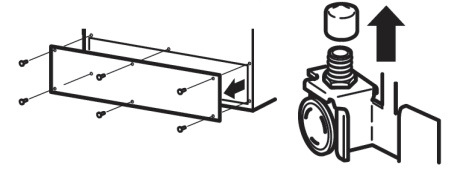
NOTE: Be sure to save the screws as the access cover must be reinstalled later to ensure your refrigerator will function properly
3. Place the compression nut and sleeve onto the end of the tubing as shown. Insert the end of the tubing into the water valve connection as far as possible. While holding the tubing, tighten the fitting.
For plastic tubing, insert the molded end of the tubing into the water valve connection and tighten compression nut until it is hand-tight; then tighten one additional turn with a wrench. Overtightening may cause leaks.
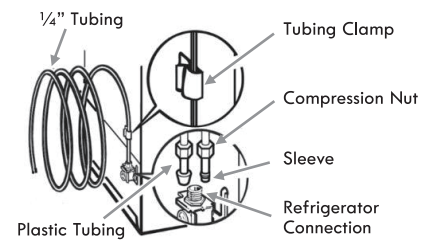
4. Use the tube clamp on the back of the refrigerator to secure the tubing to the refrigerator as shown. This will help avoid damage to the tubing when the refrigerator is pushed back against the wall.
5. Turn shuoff valve ON. Reattach the access cover.
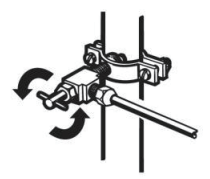
6. Check for leaks. Tighten any connections (including connections at the valve) or nuts that leak.
7. The icemaker is equipped with a built-in water strainer. If your water conditions require a second water strainer, install it in the Va” (6.35 mm) water line at either tube connection. Obtain a water strainer from your nearest appliance dealer.
Complete the Installation
- Plug into a grounded 3 prong outlet.
- Start the icemaker. Move the feeler arm to the ON (down) position. The icemaker will not begin to operate until it reaches its operating temperature of 15°F (-9°C) or below. It will then begin operation automatically.
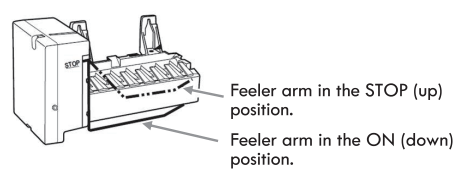
NOTE: Allow 24 hours to produce the first batch of ice. Discard the first three batches of ice produced. Allow 3 days to completely fill ice container.
In lower water pressure conditions, the water valve may turn on up to 3times to deliver enough water to the icemaker.
Refrigerator Use
Using the Controls
Your refrigerator has two controls that affect the temperature.
The Temperature control is located at the top front of the refrigerator compartment and the Airflow control is located on the back wall of the freezer compartment.
Important:
- The recommended setting should be correct for normal household refrigerator use. The controls are set correctly when milk or juice is as cold as you like and when ice cream is firm.
- Wait 24 hours for your refrigerator to cool completely before adding food. If you add food before the refrigerator has cooled completely, your food may spoil. NOTE: Adjusting the refrigerator and freezer temperature controls to a colder than recommended setting will not cool the compartments any faster.
- If the temperature is too warm or too cold in the refrigerator or freezer, first check the air vents to be sure they are not blocked before adjusting the controls.
Refrigerator Temperature Control
The temperature control dial is calibrated in a range from 1 (least cold) to 7 (coldest). For your convenience, the temperature control is preset at the factory to the recommended setting (4).

NOTE: Your refrigerator will run continuously for several hours when you first start it. This is normal.
Adjusting the Temperature Control
If you need to adjust the temperature in the refrigerator (or freezer compartment), follow the indications in the TEMPERATURE CONTROL GUIDE table.
NOTE: Do not adjust the control more than one setting at a time. Wait 24 hours between adjustments for the temperature to stabilize. a Garage Ready Settings: For optimal operation in a garage environment, set temperature control in refrigerator compartment to 4 and set temperature control in freezer compartment to Recommended.
NOTE: Sustained exposure to ambient temperatures below 39°F (4°C) may result in freezing of food and beverages stored in the refrigeration section.
Freezer Temperature Control
The temperature control dial is calibrated in a range from “Coldest” to “Cold”.
For your convenience, the Temperature control is preset at the factory to the recommended setting which is indicated on the dial.
Use the freezer temperature control to adjust the freezer temperature to your desired condition. It is recommended that when you plug in the refrigerator for the first time, make sure the control setting is on Recommended.
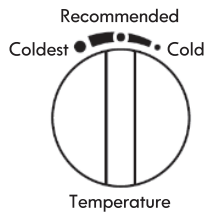
Adjusting the freezer Temperature
If you need to adjust the temperature in the freezer (or refrigerator compartment), follow the indications in the TEMPERATURE CONTROL GUIDE table below.
Important: Once the performance is achieved, return the Airflow control to the Recommended setting to keep the refrigerator operating at optimum efficiency.
TEMPERATURE CONTROL GUIDE
| Condition/reason | Adjustment |
| REFRIGERATOR too warm | Refrigerator temperature Control one setting higher |
| FREEZER too warm/too little ice | Freezer Temperature Control one setting higher |
| REFRIGERATOR too cold | Refrigerator temperature Control one setting lower |
| FREEZER too cold | Freezer Temperature Control one setting lower |
| Faster Ice Production | COLDEST |
| High Temperature location (over 90 deg F) | COLDEST - To maintain ice making production rate |
Frost Free
Your refrigerator is designed to defrost automatically
Warm Cabinet Surfaces
At times, the front of the refrigerator cabinet may be warm to the touch. This is a normal occurrence that helps prevent moisture from condensing on the cabinet. The condition will be more noticeable when you first start the refrigerator, during hot weather and after excessive or lengthy door openings.
Icemaker (on some models)
Turning the Icemaker On/Off
NOTE: Do not force the wire shutoff arm up or down.
- To turn the icemaker on, simply lower the wire shutoff arm.
NOTE: Your icemaker has an automatic shutoff. As ice is made, the ice cubes will fill the ice storage bin and the ice cubes will raise the wire shutoff arm to the OFF (arm up) position.
- To manually turn the icemaker off, lift the wire shutoff arm to the OFF (arm up) position and listen for the click to make sure the icemaker will not continue to operate.
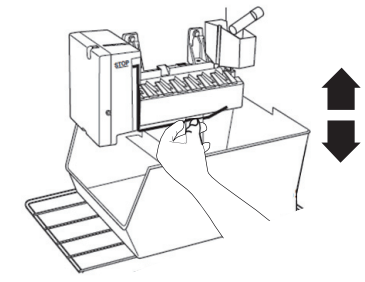
NOTE: Turn the icemaker off before removing the ice storage bin to serve ice or to clean the bin. This will keep the ice cubes from dropping out of the icemaker and into the freezer compartment. After replacing the ice storage bin, turn on the icemaker.
Ice Production Rate
- The icemaker should produce approximately 8 to 12 batches of ice in a 24 hour period. If ice is not being made fast enough, turn the freezer control toward a higher (colder) number in half steps. Wait 24 hours and, if necessary, gradually turn the freezer control to the highest setting, waiting 24 hours between each increase.
Remember
- The icemaker will not begin to operate until it reaches a temperature of 15°F (-9°C) or below. It will then begin operation automatically.
- In conditions of lower water pressure or first water supply, the icemaker water valve may turn on up to 3 times to deliver enough water to the icemaker.
- Ice will only begin to be produce after 24 hours. Discard the first three batches of ice produced. consumer can buy it from electric device stores.
- The quality of your ice will be only as good as the quality of the water supplied to your icemaker. Avoid connecting the icemaker to a softened water supply. Water softener chemicals (such as salt) can damage parts of the icemaker and lead to poor quality ice. If a softened water supply cannot be avoided, make sure the water softener is operating properly and is well maintained.
- Do not store anything on top of the icemaker or in the ice storage bin.
REFRIGERATOR FEATURES
Crisper
Crisper Drawers
The Crispers provide a storage area for fruit and vegetables.
Excess water that may accumulate in the bottom of the drawers or under the drawers should be wiped dry.
To remove and replace the crisper drawer:
- Slide the crisper drawer straight out to the stop. Lift the front and slide the drawer out the rest of the way.
- Replace the drawer by sliding the drawer in fully past the stop.
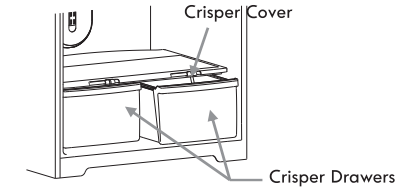
NOTE: If the refrigerator door prevents you from taking out a crisper drawer, first try removing any obstructing door bins. If bin removal still does not provide enough clearance, the refrigerator will need to be rolled forward from its installation position until the door can be opened enough to glide the drawers out.
Crisper Cover
To remove and replace the crisper cover:
1. Remove the food from the cover and then the crisper drawers.
2. Remove the glass pane from the cover frame.
3. Slightly lift up the front of the crisper cover frame.
4. Support the cover from underneath to lift it up and then out of the cabinet.
5. To replace the cover, tilt front of cover frame slightly up and carefully insert the back of the cover frame into the cabinet.
With the cover front tilted slightly upward, carefully insert the cover top back into the cabinet.
6. Position the back and sides of the cover on the supports and let the cover top settle into place.
7. Replace the glass by pushing the front edge firmly into the crisper cover. Replace the drawers.

Crisper Humidity Control
You can control the amount of humidity in the moisture-sealed crisper. For most fruits, slide the control (select models) to “lo” to provide and vegetables with skins lower humidity conditions in the drawer. For leafy vegetables, slide the control to “hi” to provide higher humidity conditions in the drawer. For best results, keep the crisper drawers tightly closed.

- Fruit: Wash, let dry and store in refrigerator in plastic bag or crisper. Do not wash or hull berries until they are ready to use. Sort and keep berries in original container in crisper, or store in a loosely closed paper bag on a refrigerator shelf.
- Vegetables with skins: Place in plastic bag or plastic container and store in crisper.
- Leafy vegetables: Wash in cold water, drain and trim or tear off bruised and discolored areas. Place in plastic bag or plastic container and store in crisper.
REFRIGERATOR CARE
Cleaning
Both the refrigerator and freezer sections defrost automatically. However, clean both sections about once a month to avoid buildup of odors. Wipe up spills immediately.
Important: Because air circulates between both sections, any odors formed in one section will transfer to the other. You must thoroughly clean both sections to eliminate odors. To avoid odor transfer and drying out of food, wrap or cover foods tightly.
To Clean Your Refrigerator
Warning: To avoid electrical shock which can cause severe personal injury or death, disconnect the power cord before moving or cleaning the refrigerator.
NOTE: Do not use abrasive or harsh cleaners such as window sprays, scouring cleansers, flammable fluids, cleaning waxes, concentrated detergents, bleaches or cleansers containing petroleum products on exterior surfaces (doors and cabinet), plastic parts, interior and door liners or gaskets. Do not use paper towels, scouring pads, or other harsh cleaning tools.
- Unplug refrigerator or disconnect power.
- Hand wash, rinse, and dry removable parts and interior surfaces thoroughly. Use a clean sponge or soft cloth and a mild detergent in warm water.
- Clean the exterior surfaces.
Painted metal: Wash painted metal exteriors with a clean, soft cloth or sponge and a mild detergent in warm water. Rinse surfaces with clean,warm water and dry immediately to avoid water spots.
Stainless Steel: Wash stainless steel surfaces with a clean, soft cloth or sponge and a mild detergent in warm water. Rinse surfaces with clean, warm water and dry immediately to avoid water spots.
NOTE: When cleaning stainless steel, always wipe in the direction of the grain to avoid cross-grain scratching.
Stainless Steel Cleaner
For best cleaning results, use Kenmore Stainless Steel Cleaner item #02240083 or equivalent. Available on Kenmore.com or by calling 1-844-553-666Z
4. There is no need for routine condenser cleaning in normal home operating environments. If the environment is particularly greasy or dusty, or there is significant pet traffic in the home, the condenser should be cleaned every 2 to 3 months to ensure maximum efficiency.
If you need to clean the condenser:
* Remove the base grille. See Front Base Grille in Installation Instructions section.
* Use a vacuum cleaner with a soft brush to clean the grille, the open areas behind the grille and the front surface area of the condenser.
* Replace the base grille when finished.
5. Plug in refrigerator or reconnect power.
Vacation and Moving Care
Vacations
If you choose to leave the refrigerator on while you’re away:
- Use up any perishables and freeze other items.
- If your refrigerator has an automatic icemaker, and is connected to the household water supply, turn off the water supply to the refrigerator. Property damage can occur if the water supply is not turned off.
- If you have an automatic icemaker, turn off the icemaker. NOTE: Raise the wire shutoff arm to OFF (up) position.
- Empty the ice bin.
If you choose to turn off the refrigerator before you leave:
1. Remove all food from the refrigerator.
2. Disconnect the refrigerator from the electrical outlet.
3. If your refrigerator has an automatic icemaker:
• Turn off the water supply to the icemaker at least one day ahead of time.
• When the last load of ice drops, raise the wire shutoff arm to the OFF (up) position.
• Bleed the water from the icemaker fill line and dry the icemaker thoroughly.
4. Clean refrigerator, wipe it, and dry well.
5. Tape rubber or wood blocks to the tops of both doors to prop them open far enough for air to get in. This stops odor and mold from building up.
NOTE: If using an automatic icemaker, discard first two or three ice harvests, when refrigerator is put back into service .
Moving
1. If your refrigerator has an automatic icemaker:
• Turn off the water supply to the icemaker at least one day ahead of time.
• Disconnect the water line from the back of the refrigerator.
• When the last load of ice drops, raise the wire shutoff arm to the OFF (up) position.
2. Remove all food from the refrigerator and pack all frozen food in dry ice.
3. Empty the ice bin.
4. Unplug refrigerator.
5. Clean, wipe, and dry thoroughly.
6. Take out all removable parts, wrap them well, and tape them together so they don’t shift and rattle during the move.
7. Depending on the model, raise the front of the refrigerator so it rolls more easily OR raise the leveling legs so they don’t scrape the floor.
8. Tape the doors closed and tape the power cord to the back of the refrigerator.
When you get to your new home, put everything back and refer to the “Installation Instructions” section for preparation instructions. Also, if your refrigerator has an automatic icemaker, remember to reconnect the water supply to the refrigerator.
TROUBLESHOOTING GUIDE
GENERAL OPERATION
| Problem | Possible Causes | What to Do |
| The refrigerator will not operate | Not connected to an electrical supply | Plug the power cord into a grounded 3 prong outlet. Do not use an extension cord. |
| No power to the electrical outlet. | Plug in a lamp to see if the outlet is working. | |
| Household fuse blown or circuit breaker tripped. | Replace the fuse or reset the circuit breaker. If the problem continues, contact an electrician. | |
| New installation | Allow 24 hours following installation for the refrigerator to cool completely. | |
| Runs too long, too frequently | Today’s refrigerators start and stop more often to maintain even temperatures. | Wait 24 hours for refrigerator to completely cool down (see “Temperature Controls” page). |
| Normal at startup for new or recently installed units. | ||
| Prolonged or frequent door openings. | This is normal. Minimize door openings. | |
| Door not sealing. | Check to see if something is preventing door from closing. | |
| Front base grille blocked. | Unblock to allow warm air to exit unit. | |
| The door will not close completely | The door is blocked open | Move food packages away from door. Push bin or shelf back into the correct position. Make sure the crisper cover is fully pushed in, so that the back rests on the supports. |
| The door is difficult to open | Gaskets are dirty or sticky. | Clean gaskets and contact surfaces with mild soap and warm water. Rinse and dry with soft cloth. |
| Warm air from cabinet bottom | This is normal air flow for condenser circulation. | |
| There is interior moisture buildup. | Humid room | Contributes to moisture buildup in the refrigerator. |
| Door(s) opened often or not closed completely. | Allows humid air to enter the refrigerator. Minimize door openings and keep door fully closed. | |
| Cabinet vibrates | Cabinet not level. Weak floor. | Level cabinet. |
| Odor in cabinet | Odor producing foods not covered. | Cover or wrap odorous foods tightly. Clean cabinet. |
TEMPERATURE
| Problem | Possible Causes | What to Do |
| Freezer, refrigerator too warm | New installation | Allow 24 hours following installation for the refrigerator to cool completely. |
| Control set too warm. Prolonged door openings. | Adjust temperature control. Minimize door openings. | |
| A large amount of warm food has been recently added. | Allows several hours for refrigerator to return to normal temperature. | |
| Products with high sugar content may not harden completely when frozen. | ||
| Freezer, refrigerator too cold | Control set too cold. | Adjust temperature control. |
NOISE
| Problem | Possible Causes | What to Do |
The refrigerator is noisy NOTE: Refrigerator noise has been reduced over the years. Due to this reduction in operating noise, you may notice unfamiliar noises that are normal. | Normal noise: buzzing | Heard when the water valve opens to fill the icemaker |
| Normal noise: clicking/Snapping | Valves opening or closing | |
| Normal noise: pulsating | Fans/compressor adjusting to optimize performance | |
| Normal noise: sizzling/Gurgling | Water dripping on the heater during defrost cycle | |
| Normal noise: popping | Contraction/expansion of inside walls, especially during initial cool-down. | |
| Normal noise: water running | May be heard when ice melts during the defrost cycle and water runs into the drain pan. | |
| Normal noise: creaking/cracking | Occurs as ice is being ejected from the icemaker mold. | |
| Cabinet not level. | Level cabinet. |
Icemaker
| Problem | Possible Causes | What to Do |
| The icemaker is not producing ice or not enough ice (on some models) | The icemaker is not connected to a water supply | Connect refrigerator to water supply and turn water shutoff valve fully open. |
| A kink in the line can reduce water flow | Straighten the water source line | |
| Icemaker is not turned on | Make sure the icemaker wire shutoff arm or switch (depending on model) is in the ON position. | |
| New installation | Ice will only begin to be produce after 24 hours. | |
| Large amount of ice recently removed | Allow sufficient time for icemaker to produce more ice. | |
| Ice cube jammed in the icemaker ejector arm | Remove ice from the ejector arm with a plastic utensil. | |
| A reverse osmosis water filtration system connected to your cold water supply can decrease water pressure | See “Water Supply Requirements.” | |
The ice cubes are hollow or small (on some models) NOTE: This is an indication of low water pressure. | The water valve is not completely open | Turn the water shutoff valve fully open |
| A kink in the line can reduce water flow | Straighten the water source line. | |
| A reverse osmosis water filtration system connected to your cold water supply can decrease water pressure | See “Water Supply Requirements" | |
| Supply line or shuoff valve is clogged. | Call a licensed, qualified plumber | |
| Off-taste, odor or gray color in the ice (on some models) | New plumbing connections can cause discolored or off-flavored ice | Discard the ice and wash the ice storage bin. Allow 24 hours for the icemaker to make new ice, and discard the first 3 batches of ice produced. |
| Ice stored too long can develop an off-taste | Discard ice. Wash ice bin. Allow 24 hours for icemaker to make new ice. | |
| Food odor transferring to ice | Use airtight, moisture proof packaging to store food. | |
| There are minerals (such as sulfur) in the water | A water filter may need to be installed to remove the minerals. |
See other models: 41072 66513543N414 91382 17383 99249